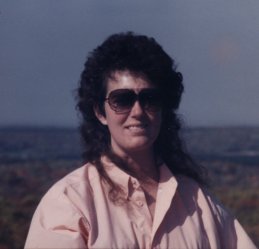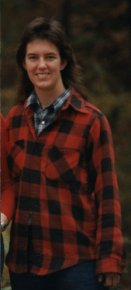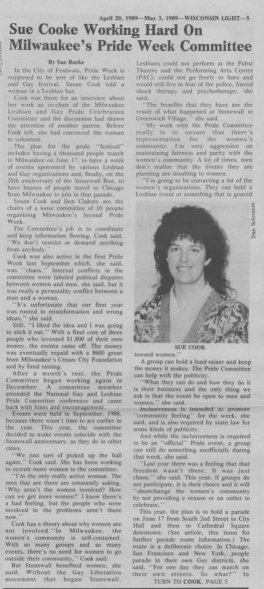|
 |
|||||||
|
(Susan Cook was the subject of an interview by the Milwaukee LGBT History Project early in 2003, and was featured in a display first appearing at PrideFest 2003, excerpts of which appear below.) "I think back to the bomb threats and death threats, and now we can say 'gay' and 'lesbian' openly pretty much anywhere. We have flags hanging from our bars where before we had blue lights. We have rainbow neon signs on our bars. We are very out. And I think PrideFest had a lot to do with that. Sometimes it was necessary to get in their face. But this is the result. A lot of people probably never knew about that little baseball tournament behind Mitchell domes and that little picnic and that little march, but this is what it's become..." Sue Cook did it twice - she helped create LGBT community in Milwaukee by starting the Milwaukee Lesbian and Gay Pride Committee (MLGPC) in 1987, then worked with the new PrideFest from 1997 to 1999. And to think, in 1983 she wasn't even out of the closet yet. She was in a relationship with a woman, but neither of them acknowledged being lesbian, even to each other. Cook remembers her heart pounding as she grabbed a flyer about lesbian/gay issues from a table at the UWM Union, where she was a student at the time. She stuffed it into her book bag and waited until she got home before reading it. She got involved in MLGPC through Grapevine, a women's organization. The first organizers of MLGPC sent invitations to other groups, asking them to send representatives to a meeting. Many of the lesbians perceived that the gay men had already made all the decisions, leaving the lesbians out of the process, so they left. Sue decided to stick it out. As MLGPC became more visible, Cook and other members endured bomb threats and death threats. Out of those threats came a large meeting of lesbians, who decided to create the Lesbian Alliance of Metro Milwaukee (LAMM). Of course, Cook knew how to take care of herself. In the late 1980s, she recalls, it was not unusual for straight men to come into lesbian bars to harass the women inside and try to pick fights. They would also wait outside for women to leave the bars. One night, she and her partner smacked a guy with the door as they were leaving their favorite bar. They saw four other men waiting down the street, so they walked off in the other direction. Cook's partner was into leather at the time, and they were both decked out. They decided there was something wrong with this picture. They turned around and started running toward the men in the street - who ran away. "I think it's important for the younger crowd that they should go back to our history. They need to know this stuff. They may not have known about our struggle, and there will be struggles ahead. You never know how the law will stand 10 years, 20 years from now, because just as the pendulum can swing to the left, it swings back to the right. And you see challenges all over the country, laws being challenged and repealed. Just because it's this way now doesn't mean it will always be this way. It is important for people to know our history and bear that in mind." |
 image1  image2  Article about Pride Committee work, May 1989 (Wis Light vol 2 issue 8) View page 2 of article |
Interview by Michael Doylen and Laura Sutherland.
History Project interview summarized by William B. Turner.
Photos by Jerry Johnson, Wisconsin Light, and the subject.
Last updated: 23-October-2005.